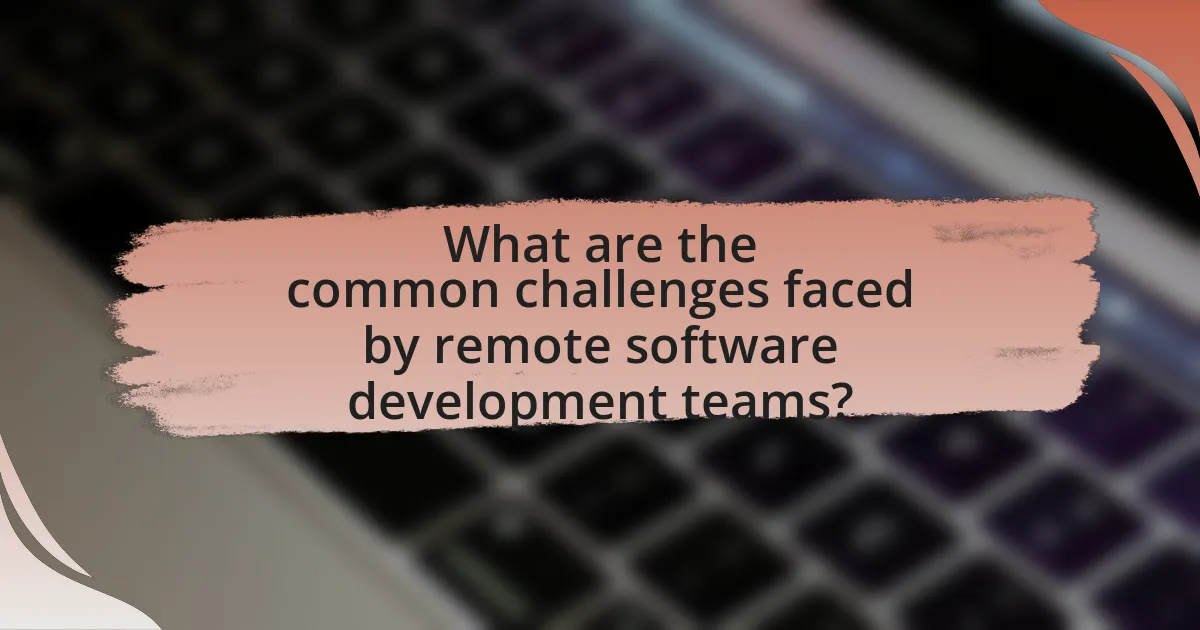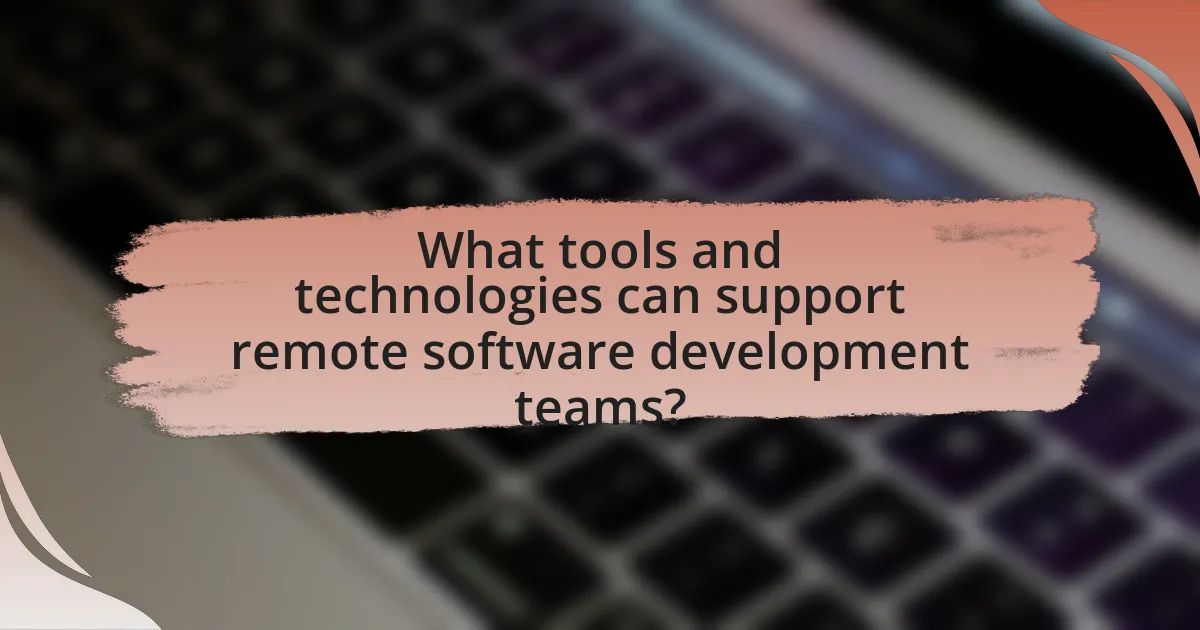Remote software development teams encounter various challenges, including communication barriers, time zone differences, and collaboration difficulties. These issues can lead to misunderstandings, delays, and reduced productivity. Effective communication tools, clear strategies for overcoming language and cultural differences, and structured scheduling practices are essential for enhancing collaboration. Additionally, fostering team cohesion through virtual bonding activities and implementing project management software can significantly improve accountability and workflow. This article provides insights into the common obstacles faced by remote software development teams and offers practical solutions to enhance their productivity and effectiveness.

What are the common challenges faced by remote software development teams?
Remote software development teams commonly face challenges such as communication barriers, time zone differences, and difficulties in collaboration. Communication barriers arise from the lack of face-to-face interaction, which can lead to misunderstandings and reduced clarity in project requirements. Time zone differences complicate scheduling meetings and coordinating tasks, often resulting in delays. Additionally, difficulties in collaboration stem from the reliance on digital tools, which may not fully replicate the dynamics of in-person teamwork. According to a study by Buffer in 2021, 20% of remote workers cited collaboration and communication as their biggest struggles, highlighting the significance of these challenges in remote software development.
How do communication barriers impact remote software development?
Communication barriers significantly hinder remote software development by causing misunderstandings, delays, and reduced collaboration among team members. These barriers can arise from differences in time zones, language proficiency, and cultural contexts, which complicate effective information exchange. For instance, a study by the Project Management Institute found that poor communication is a primary factor in 56% of project failures, highlighting the critical role of clear communication in successful software development. Additionally, remote teams may struggle with non-verbal cues, leading to misinterpretations of intent and feedback, further exacerbating project challenges.
What tools can facilitate better communication among remote teams?
Tools that can facilitate better communication among remote teams include Slack, Microsoft Teams, Zoom, and Trello. Slack provides real-time messaging and file sharing, enhancing team collaboration. Microsoft Teams integrates chat, video conferencing, and file storage, streamlining communication. Zoom offers high-quality video calls, which are essential for virtual meetings. Trello aids in project management, allowing teams to visualize tasks and progress, thereby improving clarity and accountability. These tools are widely adopted in remote work environments, as evidenced by a 2021 report from Buffer, which found that 98% of remote workers prefer using collaborative tools to enhance communication.
How can teams overcome language and cultural differences?
Teams can overcome language and cultural differences by implementing clear communication strategies and fostering an inclusive environment. Establishing a common language for communication, such as English, can help bridge gaps, while utilizing translation tools can assist non-native speakers. Additionally, promoting cultural awareness through training and team-building activities enhances mutual respect and understanding among team members. Research indicates that diverse teams can outperform homogeneous ones when effectively managed, as seen in a study by McKinsey & Company, which found that companies in the top quartile for ethnic and cultural diversity are 33% more likely to outperform their peers on profitability.
What role does time zone difference play in remote collaboration?
Time zone differences significantly impact remote collaboration by creating challenges in scheduling meetings and coordinating tasks among team members located in various regions. These differences can lead to delays in communication, as team members may not be available simultaneously, which can hinder project progress and decision-making. For instance, a study by Buffer in 2021 found that 20% of remote workers cited time zone differences as a major challenge affecting their productivity. This highlights the necessity for teams to establish clear communication protocols and flexible working hours to mitigate the effects of time zone disparities.
How can teams effectively manage scheduling across different time zones?
Teams can effectively manage scheduling across different time zones by utilizing tools that facilitate real-time collaboration and by establishing clear communication protocols. Tools like world clock applications and scheduling software, such as Google Calendar or Doodle, allow teams to visualize overlapping working hours and find suitable meeting times. Additionally, setting a standard time zone for all scheduling, such as Coordinated Universal Time (UTC), helps eliminate confusion. Research indicates that companies using these strategies report a 30% increase in meeting attendance and engagement, demonstrating the effectiveness of structured scheduling practices in remote environments.
What strategies can help maintain productivity despite time zone challenges?
To maintain productivity despite time zone challenges, implementing asynchronous communication strategies is essential. Asynchronous communication allows team members to work at their own pace and respond when it is convenient for them, which is particularly beneficial when team members are spread across different time zones. Research indicates that teams utilizing tools like Slack or Trello for project management and communication can enhance collaboration and reduce delays caused by time zone differences. Additionally, establishing clear expectations regarding response times and deadlines can further streamline workflows, ensuring that all team members remain aligned and productive regardless of their geographical location.
Why is team cohesion important in remote software development?
Team cohesion is crucial in remote software development because it enhances collaboration and productivity among team members. When team members feel connected and aligned, they communicate more effectively, share knowledge, and support each other in problem-solving. Research indicates that cohesive teams are 25% more productive than their less cohesive counterparts, as they can leverage their collective strengths and maintain motivation despite the challenges of remote work. Additionally, strong team cohesion reduces feelings of isolation, which is common in remote settings, thereby improving overall job satisfaction and retention rates.
What activities can foster team bonding in a virtual environment?
Virtual team bonding can be fostered through activities such as virtual team-building games, online workshops, and regular video check-ins. These activities encourage interaction and collaboration among team members, which is essential for building relationships in a remote setting. For instance, virtual escape rooms and trivia games have been shown to enhance communication and teamwork skills, leading to improved collaboration. Research indicates that teams engaging in structured activities report higher levels of trust and camaraderie, which are critical for effective remote software development.
How can leaders promote a sense of belonging among remote team members?
Leaders can promote a sense of belonging among remote team members by fostering open communication and creating inclusive team rituals. Open communication allows team members to express their thoughts and feelings, which builds trust and connection. For instance, regular check-ins and feedback sessions can help team members feel valued and heard. Additionally, inclusive team rituals, such as virtual coffee breaks or team-building activities, can strengthen relationships and enhance camaraderie. Research indicates that teams with strong social connections are 50% more productive, highlighting the importance of belonging in remote work environments.

How can remote software development teams enhance their productivity?
Remote software development teams can enhance their productivity by implementing effective communication tools and practices. Utilizing platforms like Slack or Microsoft Teams facilitates real-time collaboration, reducing delays in information sharing. Research indicates that teams using structured communication methods report a 25% increase in project completion rates, as highlighted in the “State of Remote Work” report by Buffer in 2021. Additionally, establishing clear goals and regular check-ins helps maintain focus and accountability, further driving productivity.
What best practices can improve workflow in remote teams?
Implementing structured communication channels significantly improves workflow in remote teams. Regular check-ins, utilizing tools like Slack or Microsoft Teams, and establishing clear protocols for updates ensure that team members stay aligned and informed. Research indicates that teams with defined communication strategies experience a 25% increase in productivity, as they reduce misunderstandings and streamline collaboration. Additionally, setting clear goals and deadlines enhances accountability, leading to more efficient task completion.
How can agile methodologies be adapted for remote environments?
Agile methodologies can be adapted for remote environments by leveraging digital collaboration tools and establishing clear communication protocols. Remote teams can utilize platforms like Jira or Trello for task management, ensuring visibility and accountability. Daily stand-ups can be conducted via video conferencing tools such as Zoom or Microsoft Teams, maintaining the rhythm of regular check-ins. Additionally, fostering a culture of trust and transparency is essential, as studies show that effective communication increases team performance by up to 25%. By integrating these practices, remote teams can effectively implement agile principles while overcoming the challenges posed by physical distance.
What role does project management software play in enhancing productivity?
Project management software significantly enhances productivity by streamlining communication, task allocation, and progress tracking within teams. This software centralizes project information, allowing team members to collaborate effectively regardless of their physical location. For instance, tools like Trello and Asana enable real-time updates and visibility into project statuses, which reduces the time spent on status meetings and email exchanges. Research by the Project Management Institute indicates that organizations using project management software can improve project success rates by up to 28%, demonstrating its effectiveness in optimizing workflows and resource management.
How can remote teams ensure accountability and transparency?
Remote teams can ensure accountability and transparency by implementing structured communication protocols and utilizing project management tools. Structured communication, such as regular check-ins and updates, fosters an environment where team members are aware of each other’s progress and responsibilities. Tools like Trello or Asana allow for task assignments and tracking, making it clear who is responsible for what and when tasks are due. Research indicates that teams using project management software report a 20% increase in productivity due to enhanced visibility and accountability among members.
What metrics should be used to track team performance remotely?
To track team performance remotely, key metrics include productivity, communication effectiveness, and employee engagement. Productivity can be measured through completed tasks, code commits, or project milestones, providing a clear indication of output. Communication effectiveness can be assessed via response times in collaboration tools and the frequency of team meetings, which reflect how well team members are interacting. Employee engagement can be gauged through surveys measuring job satisfaction and participation in team activities, indicating the overall morale and commitment of the team. These metrics collectively offer a comprehensive view of remote team performance, ensuring that teams remain aligned and productive despite geographical distances.
How can regular check-ins and feedback loops improve accountability?
Regular check-ins and feedback loops enhance accountability by creating structured opportunities for team members to discuss progress and challenges. These interactions foster transparency, as individuals are required to report on their tasks and receive input from peers and managers. Research indicates that teams with consistent feedback mechanisms experience a 25% increase in productivity, as accountability encourages individuals to meet their commitments and deadlines. Furthermore, regular communication helps identify issues early, allowing for timely interventions that keep projects on track, thereby reinforcing a culture of responsibility within remote software development teams.
What are effective strategies for managing remote team members?
Effective strategies for managing remote team members include establishing clear communication channels, setting defined goals, and fostering a strong team culture. Clear communication channels, such as regular video calls and instant messaging platforms, ensure that team members stay connected and informed. Setting defined goals helps align team efforts and provides measurable outcomes, which is crucial for remote work where visibility can be limited. Fostering a strong team culture through virtual team-building activities and recognition programs enhances collaboration and morale. Research from Buffer’s “State of Remote Work” report indicates that communication and collaboration are the top challenges faced by remote teams, highlighting the importance of these strategies in overcoming such obstacles.
How can leaders provide support and resources to remote developers?
Leaders can provide support and resources to remote developers by implementing structured communication channels, offering access to necessary tools, and fostering a culture of collaboration. Structured communication, such as regular video meetings and instant messaging platforms, ensures that remote developers stay connected and informed about project developments. Providing access to essential tools, including project management software and code repositories, enables developers to work efficiently and effectively. Additionally, fostering a culture of collaboration through team-building activities and recognition programs enhances morale and encourages knowledge sharing among remote team members. These strategies are supported by research indicating that effective communication and resource availability significantly improve remote team performance and job satisfaction.
What techniques can be used to motivate remote team members?
To motivate remote team members, techniques such as regular communication, recognition of achievements, and fostering a sense of community are effective. Regular communication through video calls and messaging platforms helps maintain engagement and clarity on tasks. Recognizing achievements, whether through shout-outs in team meetings or reward systems, boosts morale and encourages productivity. Additionally, fostering a sense of community through virtual team-building activities can strengthen relationships and enhance collaboration. Research indicates that teams with strong social connections are 50% more productive, highlighting the importance of these techniques in motivating remote workers.

What tools and technologies can support remote software development teams?
Remote software development teams can be effectively supported by tools and technologies such as version control systems, project management software, communication platforms, and cloud-based development environments. Version control systems like Git enable teams to collaborate on code efficiently, allowing multiple developers to work on the same project without conflicts. Project management tools such as Jira or Trello help in tracking progress, assigning tasks, and managing deadlines, which is crucial for remote coordination. Communication platforms like Slack or Microsoft Teams facilitate real-time discussions and file sharing, enhancing team collaboration. Additionally, cloud-based development environments, such as GitHub Codespaces or AWS Cloud9, provide accessible coding environments that can be utilized from anywhere, ensuring that all team members have the necessary resources to contribute effectively. These tools collectively address the challenges of remote collaboration by improving communication, organization, and access to resources.
What are the essential tools for communication and collaboration?
The essential tools for communication and collaboration in remote software development teams include video conferencing platforms, instant messaging applications, project management software, and collaborative document editing tools. Video conferencing platforms like Zoom and Microsoft Teams facilitate real-time meetings, enabling teams to discuss project updates and resolve issues efficiently. Instant messaging applications such as Slack and Microsoft Teams allow for quick communication and information sharing, which is crucial for maintaining team cohesion. Project management software like Jira and Trello helps teams organize tasks, track progress, and manage deadlines effectively. Collaborative document editing tools such as Google Workspace and Microsoft 365 enable multiple team members to work on documents simultaneously, enhancing productivity and ensuring everyone has access to the latest information. These tools collectively address the challenges of remote collaboration by fostering communication, organization, and teamwork.
How do video conferencing tools enhance remote team interactions?
Video conferencing tools enhance remote team interactions by facilitating real-time communication and collaboration among team members. These tools allow participants to engage in face-to-face conversations, which fosters a sense of connection and reduces feelings of isolation often experienced in remote work settings. According to a study by the Harvard Business Review, teams that utilize video conferencing report higher levels of engagement and productivity compared to those relying solely on email or chat. Additionally, video conferencing enables screen sharing and collaborative document editing, which streamlines project discussions and decision-making processes, ultimately improving team efficiency and cohesion.
What project management tools are most effective for remote teams?
Effective project management tools for remote teams include Trello, Asana, and Jira. Trello offers a visual board system that enhances task tracking and collaboration, making it suitable for teams needing a straightforward interface. Asana provides robust project tracking features and integrates well with other tools, facilitating communication and workflow management. Jira is specifically designed for software development teams, offering agile project management capabilities that support sprint planning and issue tracking. These tools have been widely adopted in the industry, with Trello boasting over 50 million users and Asana reporting more than 107,000 organizations using its platform, demonstrating their effectiveness in enhancing productivity and collaboration among remote teams.
How can version control systems benefit remote software development?
Version control systems benefit remote software development by enabling efficient collaboration, tracking changes, and maintaining code integrity. These systems allow multiple developers to work on the same codebase simultaneously without conflicts, as they can manage different versions of files and merge changes seamlessly. For instance, Git, a widely used version control system, supports branching and merging, which facilitates parallel development and reduces the risk of overwriting each other’s work. Additionally, version control systems provide a history of changes, allowing teams to revert to previous versions if necessary, thus enhancing code stability and reliability. This capability is crucial for remote teams, as it ensures that all members can access the latest updates and maintain a cohesive workflow, regardless of their physical location.
What are the best practices for using Git in a remote setting?
The best practices for using Git in a remote setting include maintaining a clear branching strategy, using descriptive commit messages, and regularly synchronizing with the remote repository. A clear branching strategy, such as Git Flow or feature branching, helps teams manage parallel development efforts effectively. Descriptive commit messages enhance collaboration by providing context for changes, making it easier for team members to understand the history of the project. Regular synchronization with the remote repository, through frequent pulls and pushes, minimizes merge conflicts and ensures that all team members are working with the latest codebase. These practices are supported by industry standards, as effective version control is crucial for maintaining code quality and facilitating collaboration in distributed teams.
How can teams ensure code quality and collaboration through version control?
Teams can ensure code quality and collaboration through version control by implementing practices such as regular code reviews, branching strategies, and automated testing. Regular code reviews facilitate peer feedback, which helps identify issues early and promotes knowledge sharing among team members. Branching strategies, like Git Flow, allow teams to work on features independently while maintaining a stable main branch, reducing integration conflicts. Automated testing ensures that code changes do not introduce new bugs, as continuous integration tools can run tests on every commit. These practices collectively enhance code quality and foster collaboration, as evidenced by studies showing that teams using version control effectively report higher productivity and fewer defects in their software.
What emerging technologies can improve remote software development?
Emerging technologies that can improve remote software development include cloud computing, artificial intelligence, and collaborative tools. Cloud computing enables developers to access resources and environments from anywhere, facilitating seamless collaboration and deployment. Artificial intelligence enhances productivity by automating repetitive tasks, providing code suggestions, and improving debugging processes. Collaborative tools, such as version control systems and project management software, streamline communication and task tracking among distributed teams. These technologies collectively address the challenges of remote work by fostering efficiency, enhancing collaboration, and ensuring consistent access to necessary resources.
How can AI and automation streamline remote workflows?
AI and automation can streamline remote workflows by enhancing communication, optimizing task management, and reducing manual processes. For instance, AI-driven tools like chatbots facilitate instant communication among team members, ensuring that queries are addressed promptly, which is crucial for remote collaboration. Additionally, automation tools can manage project timelines and allocate resources efficiently, minimizing delays and improving productivity. Research indicates that companies implementing automation in their workflows experience a 20-30% increase in efficiency, demonstrating the tangible benefits of these technologies in remote settings.
What role does cloud computing play in remote software development?
Cloud computing is essential in remote software development as it provides scalable resources and collaborative tools that enhance productivity. By enabling developers to access shared environments and tools from anywhere, cloud computing facilitates real-time collaboration and integration of work across distributed teams. According to a report by Gartner, 70% of organizations are using cloud services to improve their software development processes, demonstrating its critical role in streamlining workflows and reducing deployment times.
What practical tips can help remote software development teams succeed?
Remote software development teams can succeed by implementing clear communication protocols, utilizing project management tools, and fostering a strong team culture. Clear communication protocols, such as regular stand-up meetings and defined channels for feedback, ensure that all team members are aligned and informed. Utilizing project management tools like Jira or Trello helps in tracking progress and managing tasks efficiently, which is crucial for remote collaboration. Fostering a strong team culture through virtual team-building activities and recognition of individual contributions enhances morale and collaboration. Research indicates that teams with effective communication and collaboration tools are 50% more productive, highlighting the importance of these practices in remote settings.

Leave a Reply